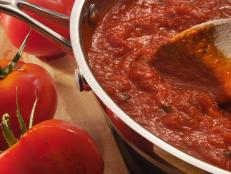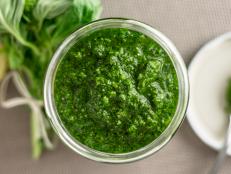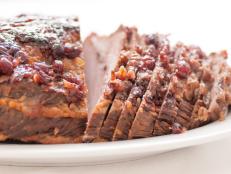How to Thicken a Sauce 6 Ways
Here, the best way to thicken every type of sauce, from gravies to tomato sauce.
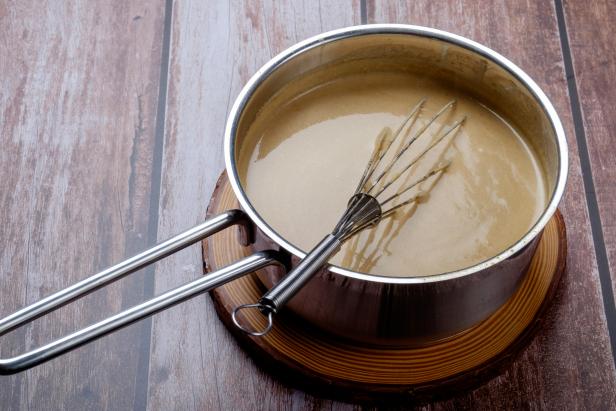
roemart/Getty Images
Whether it’s a dribbly gravy or a watery pasta sauce, if a sauce is not thick enough to cling to your food, it’s time for triage. The good news? There is always a way to fix a runny sauce. Here are the top six ways to repair them, from tomato sauces to gravies to cream sauces and more.
How to Thicken a Sauce
Test your sauce first by dipping a wooden spoon in it and then looking at the back of it. This will give you an idea of how close it is to coating; it may need just a little tweak, or you might need to thicken it more aggressively. Here are six ways to adjust it that work for the most common cooked sauces.
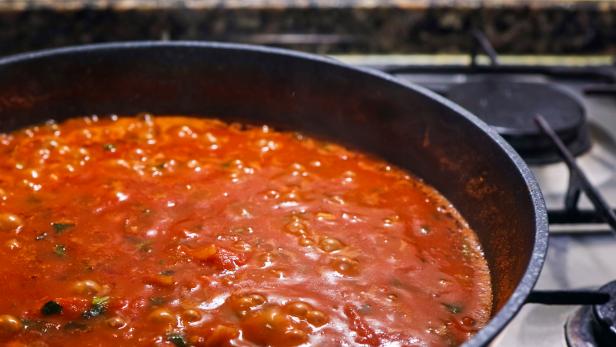
Pavel Samsonov/Getty Images
1. How to Thicken a Sauce by Cooking It Down
Works best for: tomato sauces, fruit sauces, braising liquids
Letting evaporation cook out water and concentrate your sauce is one of the easiest ways to thicken it, if not the quickest. All you need to do is place your sauce on the stove, adjust the heat and let time do the rest. This is best for sauces which already have a lot of natural body, like tomato sauce and fruit sauce.
Step 1: Bring to a simmer. Adjust the heat so small bubbles burst steadily on the surface. Cook, uncovered, stirring every few minutes with a rubber spatula to make sure the bottom and sides of the pan don’t scorch.
Step 2: Test the thickness. Dip a spoon into the sauce and see how thoroughly it coats the back; this will help you judge when it has evaporated enough to coat your food.
Note that this method works by concentrating your sauce, so flavors intensify at least to some degree. If the sauce is already very salty or spicy you might want to opt for another method.
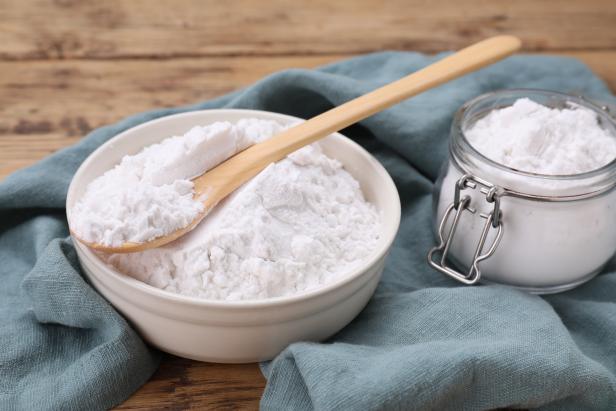
Liudmila Chernetska/Getty Images
2. How to Thicken a Sauce with Cornstarch
Works best for: gravies, stir-fry sauces, glazes, fruit sauces, dessert sauces
Cornstarch is an extremely effective thickener that works very quickly. One of its benefits is that it doesn’t change the flavor of your sauce, just binds the liquid with starch molecules for a silkier, stiffer texture. Just remember to never add it directly to the sauce since it can easily clump; mix it with liquid first.
Step 1: Make a slurry. Stir equal parts cornstarch and water or another liquid together until smooth; typically about 1 tablespoon cornstarch is recommended for 1 cup of liquid, but this can vary based on how thick your sauce is to begin with and what your desired texture is.
Step 2: Stir and cook. Have your sauce at a simmer and stir in a bit of your slurry. Let the sauce cook as you stir for a few minutes to judge the texture; stir in more if desired and cook for a few minutes more.
Step 3: Don’t overcook. Cornstarch can lose its thickening power if cooked too long, so remove the sauce from the heat once you’ve achieved your desired thickness and cooked out any raw starch taste.
3. How to Thicken a Sauce with Flour
Works best for: gravies, stews, braising liquids, cream sauces
Flour acts by binding liquid with starch molecules much like cornstarch does. And like cornstarch it can clump, so making a slurry with liquid is necessary to avoid a lumpy sauce, or you can mix it with fat (usually butter) first to form a roux or a paste (sometimes called a beurre manié, or kneaded butter). About 2 tablespoons flour per cup of simmering liquid is usually recommended, but how much you need will depend on how thin your sauce is to begin with and how thick you want the end result. Here are three ways to add flour to a sauce.
Make a Slurry: Mix equal parts flour and water or other liquid together. Stir a good amount of the mixture into simmering sauce; cook for a few minutes, then add more until you have your desired consistency. Simmer long enough to cook out any raw flour taste.
Make a Roux: Melt butter in a saucepan until foaming, or use another fat. Stir in an equal amount of flour. Your sauce ingredients can be added directly to the roux, or you can whisk the hot roux into your sauce; keep whisking until smooth. Simmer long enough to cook out any raw flour taste.
Make a Butter-and-Flour Paste: Have butter at room temperature and stir and mash an equal amount of flour into it. Whisk a good amount of the paste into your simmering sauce and let it cook for a few minutes, adding more paste if needed until the desired consistency is achieved. Simmer long enough to cook out any raw flour taste.
Note that while flour itself will not alter the taste of your sauce significantly, adding it with butter may. Make sure you’re okay with additional richness and buttery flavor, something that would be fine in a gravy or cream sauce but perhaps not in a glaze. And be aware that flour can alter the color of a sauce, giving it a lighter or cloudy appearance.
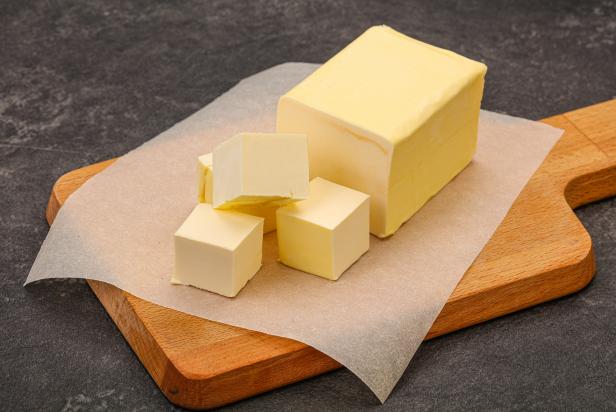
AndreySt/Getty Images
4. How to Thicken a Sauce with Butter
Works best for: pan sauces, braising liquids
Whisking in pats of cold butter is one of the classic ways to thicken a pan sauce. This method works though emulsifying the liquid with the butter, increasing thickness slightly and adding heft and clinginess so your sauce coats food better.
Step 1: Make pats of cold butter. Slice a stick of butter into small pats (about 1 to 1 1/2 teaspoons) and place them on a plate. Refrigerate them on the plate until ready to use.
Step 2: Stir or whisk over low heat. Have your sauce in a wide pan like a skillet. Have it just under a simmer on very low heat. Add one pat of cold butter and stir or whisk constantly until it completely melts. Continue adding butter one pat at a time until your sauce reaches the right consistency.
Step 3: Season. Taste the sauce and add salt and pepper (or more acid if needed) to taste. Immediately remove from the heat; use it right away or store it for 20 to 30 minutes in a warm place or in an insulated thermos until ready to use. Do not reheat the sauce or it may break.
5. How to Thicken a Sauce with Cream
Works best for: cream sauces, gravies, pasta sauces, pan sauces
Heavy cream adds a rich, silky texture to sauces; it won’t change the thickness dramatically, but it will help it cling to foods better. Not every sauce, however, was meant to be a cream sauce, so make sure a creamy one fits into your meal plan.
Step 1: Drizzle and stir. Have your sauce simmering. Start by drizzling a small amount of cream into the sauce and whisk it in. Let it simmer for a minute, then add more if you think it needs it.
Step 2: Season. Taste your sauce and adjust the seasonings if needed; the richness of cream can blunt some flavors.
6. How to Thicken a Sauce with Cheese
Works best for: pasta sauces, cream sauces, pan sauces
If you’ve got a cream sauce like Alfredo, or even a lemon sauce for cutlets, a bit of cheese could take your sauce from thin to nicely rich and clingy. Grated Parmesan is a standby for many pasta sauces, but there are other options: Small dabs of cream cheese work well, as does tangy goat cheese or mild mascarpone. Stick with soft, creamy cheeses, not rubbery ones like mozzarella or fontina, unless your aim is a gooey sauce.
Step 1: Have the sauce hot. Have the sauce simmering or almost simmering. Have the cheese grated or crumbled or in small dabs so it will combine smoothly.
Step 2: Cook and stir. Add the cheese to the sauce and stir constantly until melted and combined. Taste the sauce and adjust the seasoning; cheese is quite salty so it may not need more salt but could benefit from a bit of pepper.
Related Links:
























